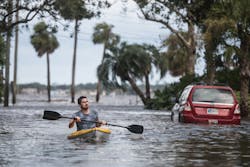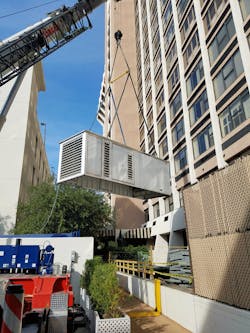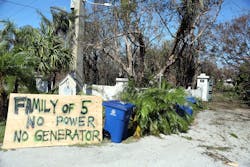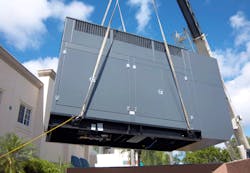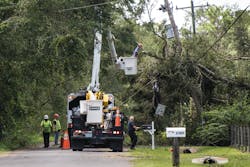Thanks to their randomness — not to mention their ability to dish out equal-opportunity misery — natural disasters have a way of spurring action where there’s been hesitation, forcing choices in the face of uncertainty and paralysis. That’s what outbreaks of powerful hurricanes and superstorms over the last dozen years look to be bringing to serious discussions of back-up electrical power, including where it’s needed, how much should be required, how to deliver it, and how to ensure it works.
Hurricane Sandy and three others in 2012 caused $75 billion in damage and exposed long-overlooked vulnerabilities in emergency power in the Northeastern United States, just as Hurricane Katrina and four others did in their $200 billion-plus Gulf Coast assaults in 2005. These clusters of storms, some with chart-busting size and power, knocked out grid power over large and, in some cases, densely populated areas, swamped on-site generators and fueling systems in low-lying areas, and exposed standby power systems that had not been maintained well enough to perform when needed.
A repeat performance came in 2017 when four more storms — Hurricanes Irma, Harvey, Jose, and Maria in quick succession — combined to cause another $200 billion in damage from Texas to the Caribbean. They wreaked similar havoc on the electrical grid and put a bold exclamation point on the emergency power issue, primarily because of one high-profile incident: the deaths of 14 residents of a Florida nursing home that lost power during Irma.
Like so many nursing homes across the country, The Rehabilitation Center at Hollywood Hills, in Hollywood, Fla., did not have standby power equipment to run air conditioning units, leaving elderly and frail residents to swelter for hours in rising heat and humidity. The failure to evacuate residents led to prolonged exposure to extreme temperatures, and 12 people ultimately died as a direct result, the country medical examiner ruled.
Meanwhile, in Puerto Rico and other Caribbean islands, fall storms scored devastating direct hits, knocking out power so extensively that many areas are still without grid power and much hope for quick restoration. They exposed not only the special vulnerability of island electrical grids to Category 5-scale storms, but also the insufficiency of many emergency power systems, including those in critical facilities, such as hospitals, nursing homes, and assisted living facilities (ALFs).
“People in Puerto Rico are still on generators six months later,” says Richard K. Ladroga, P.E., director of property loss consulting for DeSimone Consulting Engineers, N.Y., who has assessed post-hurricane infrastructure damage across the Caribbean. “But many diesel generators are also still failing, many because they haven’t been maintained like they should have been.”
Deaths spur action
But it was the Florida nursing home deaths that has helped crystallize the issue of emergency power where it’s perhaps most critical — in settings where it can mean life or death. That incident quickly resurrected a long-simmering debate over whether nursing homes and ALFs should be required to have much more robust standby power systems than ones most now must maintain to operate elevators, fire suppression systems, and life support systems. The core concern: Should they be mandated to provide standby power equipment sufficient to operate air conditioning systems capable of maintaining safe temperature ranges for an extended period?
The quick answer from the Florida governor was “yes.” Within days of the fatalities, Gov. Rick Scott issued an emergency order requiring nursing homes and ALFs to submit plans by Oct. 31, 2017, for installing emergency power systems that would be able to start immediately after a power failure and run air conditioning so ambient temperatures would stay at or below 81°F for at least 96 hours thereafter. Furthermore, plans had to be capable of implementation by Nov. 15, 2017.
That order, however, crumbled partly under pushback and formal challenges from interests representing care facilities concerned with the timing and cost-benefit considerations of the mandate. It was invalidated in late October by an administrative law judge, who said qualifying emergency conditions no longer existed and that the deadline for compliance was nonetheless “impossible” for most to meet.
“Our main concern was with the timeline — requiring plans in 60 days, which was unrealistic,” says Kristen Knapp, director of communications for the Florida Health Care Association, which represents about 550 of the state’s 680 nursing homes. “And we were looking at a cost of anywhere from $150,000 to $300,000 to put in generators of the size needed just to run air conditioning.”
Nevertheless, the state’s long-term care interests and the administration went back to the drawing board. A compromise was reached in January, mandating generators capable of powering air conditioning and maintaining 81°F temperatures in nursing homes and ALFs. The key difference: Generators don’t have to be installed. Instead, portable generators would be allowed, but with a host of stipulations. Nursing homes would need to have 72 hours of fuel on site and the ability to tap into another 24 hours’ worth in a declared emergency. ALFs would need either 48 or 72 hours of fuel on site, depending on their numbers of beds.
The January agreement left facilities facing a tight timeline to come into compliance; agencies overseeing the rules were giving them until June 1 — the official start of the hurricane season — to begin implementing standby generator projects.
The wild card, though, is the Florida Legislature. In the push to ratify the rules by the March 9 session end, as state law requires, the body was contending with numerous freshly drafted care facility generator bills containing different prescriptions for reducing the chances of a repeat of the Hollywood Hills debacle. Much of the debate centered on costs the facilities would incur under the rules, which was spawning some proposals to address the issue by some means other than standby generators.
Mandates spreading
In the absence of ratification or passage of new legislation, the state’s proposed generator mandate could die. That would hardly make Florida an outlier, as such mandates appear to be far from the rule. But some states do have laws addressing the maintenance of air conditioning — and even heat specifically — in care facilities after power outages, and storm events around the country may be moving some states to action. Ohio, for instance, was reportedly considering legislation because of Irma.
Beyond the states, the federal government is getting involved. As of last November, hospitals and other types of facilities that serve Medicare and Medicaid patients had to begin implementing a host of new emergency preparedness procedures. One requirement of the Centers for Medicare & Medicaid Services (CMS) rule, which grew out of care facility incidents during Hurricane Katrina, is that licensees provide “alternate sources of energy to maintain temperatures to protect patient health and safety and for the safe and sanitary storage of provisions.”
Eric Cote, project director for Powered for Patients, a Washington, D.C., group formed in the wake of Hurricane Sandy to address power issues facing critical health care facilities, says the new CMS rules intentionally leave the door open to a variety of emergency power solutions.
“It doesn’t require the use of generators because there are other emergency power systems out there, but generators are used in 90% of these cases,” he says. “There are more obscure technologies that could meet that need, such as battery storage, microgrids, and combined heat-power (CHP) systems.”
Shortly after the CMS rules took effect, Florida U.S. Congresswoman Debbie Wasserman-Schultz introduced the Nursing Home Comfortable Air Ready for Emergencies Act bill. As a condition for Medicare and Medicaid participation, long-term care facilities nationwide would need to have emergency power sufficient to run facility air conditioning systems. It also would create a federal loan program to help facilities fund installations.
The Hollywood Hills incident has also renewed study of whether hospitals need to ensure air conditioning stays on in a power outage. While they must have and regularly test standby power equipment for critical building functions and patient safety, they’re not required to ensure air conditioning systems stay operating.
But a Powered for Patients report issued in 2017 on the resiliency of critical health care systems stated that proposals to require hospital emergency power systems to run air conditioning “are advancing on multiple fronts.”
Hardening facilities
While 2017 storms precipitated scrutiny of residential care facilities’ ability to cope with power outages, they also helped refocus attention on the vulnerability of the nation’s power infrastructure generally, and especially elements of it that service other facilities with priority needs for uninterrupted power.
Cutting huge swaths, powerful hurricanes like Sandy, Katrina, and others of the past decade took some vital health care facilities, heavily populated public housing projects, data centers, gas stations and wastewater treatment facilities off grid power, forcing many to turn to emergency systems, some of which proved unreliable. Many institutions, industries, and jurisdictions responded with efforts to improve power reliability. Generators and fueling systems have been added, upgraded, and moved to higher ground; islanded microgrids using traditional generators and off-grid clean energy assets have been constructed; and closer monitoring of standby systems has been instituted.
In the New York City area, hard hit by Sandy, the hardening of emergency power systems has progressed steadily. By law or choice, many structures in vulnerable areas are being built or improved with generators and fuel sources securely isolated from the most remote flooding scenarios.
For instance, many public housing facilities in New York were left without power following Sandy after diesel generators and their fueling tanks flooded. Long-term plans were quickly laid to improve their resiliency, but actual progress has been slow in some quarters. In August 2017, the first of nearly 300 natural gas-powered generators specified for some three dozen properties operated by the New York City Housing Authority began to be installed. At NYU Langone Health, a New York hospital that experienced high-profile generator problems during Sandy, a new Energy Building was only recently completed in 2016. Its new generators, boilers, and CHP plant are designed to power the hospital’s entire campus in the event of an extended grid power outage.
Beyond a push for new and improved emergency power systems, there’s a growing focus on improving their functionality and reliability. A primary mission of Powered for Patients is raising health care institutions’ awareness of the critical need to regularly test, service, and maintain systems.
“There are various levels of readiness across the health care spectrum,” Cote says. “Most hospitals have emergency power installed and ready to go, but those systems can run into problems from time to time.”
To better ensure system performance, Cote says institutions should also be open to new standby power technologies, such as battery storage; emerging methods of status checking and utility communication using remote monitoring technologies; and potentially more reliable and economical generator fueling options, such as natural gas.
There’s evidence that generator reliability could be in question. A National Public Radio report that aired in the wake of the Hollywood Hills incident stated that one-third of U.S. nursing homes have been cited for failing to inspect their generators each week or to test them monthly; 1,373 facilities were cited more than once.
That’s an eye-catching statistic in the wake of a year in which another rash of powerful storms again served deadly notice that the power grid is vulnerable, and that reliable emergency power is anything but a luxury. Expanding its reach, improving its affordability, and ensuring its reliability will be central themes in the growing conversation about power continuity in an era of growing dangers and expanding risks.
In touring the Caribbean after the 2017 deluge of storms, Ladroga thinks he may have seen a vision of the future, one that will elevate attention to power infrastructure hardening, preparedness, and fail-safe systems to new levels. The grid is more vulnerable than ever, he says, and the last decade has brought that into sharper focus.
“To some degree, last year was a wake-up call,” he says. “The strength of these storms is getting people’s attention, especially when outages last as long as they have in Puerto Rico, for instance. There’s going to be a need for greater self-sufficiency and room for more visionaries to develop new ways of achieving grid independency through battery storage systems, green power, and traditional generators.”
Zind is a freelance writer based in Lees Summit, Mo. He can be reached at [email protected].
SIDEBAR: Florida Facilities Mull Back-up Plans Amidst Uncertainty
In the dark about a looming mandate for emergency power to run facility HVAC systems in a blackout, Florida nursing homes and assisted living facilities could have used some standby power in late February to light the way. As it was, clarity was in short supply. Would state lawmakers ratify a compromise allowing portable generators, or would generators have to be installed? Would alternatives or new specifics emerge? Might lawmakers even kill the mandate? No one knew for sure. Nevertheless, most facility owners plowed ahead, weighing options or making purchases as June 1 — the start of the hurricane season and the likely deadline for finalizing plans — approached.
John Knox Village of Central Florida, which lost power during hurricanes last fall, wasn’t waiting; it will replace (but not until late 2018) aging generators not configured to power HVAC systems in two campus facilities with new, larger ones that will. The installed units will provide 105 hours of emergency power and replace spot-cooling using rented air conditioning units and fans during outages, says Joseph Trainor, executive director.
“It didn’t make any difference to us what the legislature was going to do,” he says. “By the time we get residents here they’re sick, and the last thing you want to do is put stress on them.”
Many facilities are making a similar calculation, says Tim Rebholz, director of new equipment sales for Genset Services, Inc., a Pompano Beach, Fla., distributor. Larger ones with ample resources are generally making the investment now, and most are going the installed route, he says. Some are interested in mobile generators as a cheaper alternative, he adds, but designs needed to meet tougher emissions requirements have made them costlier. Plus, they pose multiple on-site fuel storage issues, and availability isn’t guaranteed.
“A week before a hurricane, those mobile units are usually gone, and they’re picked up quickly by those with contracts,” he says.
But up-front cost is a concern, and a reason many cash-strapped facilities are waiting for guidance on a rule — one that could provide funding, says Chris Hughes, P.E., president of Eau Gallie Electric, Inc., a Melbourne, Fla., company that has been consulting with facilities on design-build generator projects. Meantime, he’s drawing up installed and portable options in varying configurations, “going as cheap as I can and looking for where corners can be cut, shorter copper runs, taking a closet and turning it into an electrical room, locating the generator in a parking spot.”
Whether portable or installed, retrofitting facilities with generators poses design challenges. Many are older and not physically or electrically configured to easily integrate units sized to run HVAC or all a building’s load. Tying in a portable generator can be especially tricky.
“This is fairly easy to do in a new facility, but in an existing one that may be 40 years old it’s harder,” says Michael Dodane, president of MiGre Engineers, LLC, an MEP design firm in Longwood, Fla. “It can be hard to find AC systems that might be on 10 different panels.”
To try to economize, Rebholz says, some owners have been wanting to explore establishing small cooling zones in facilities. That might translate to savings on generator capacity, he says, but facility wiring issues could be offsetting. On the flip side, some are interested in spending more to size generators capable of powering a facility’s full load.
Another route to cheaper emergency power for such facilities is natural gas-powered generators. If permitted under the rules Florida is considering, they might be less expensive that diesel-powered units, up to a point, and could offer more assurances of uninterrupted fuel.
“A 100kW natural gas unit is about the same price as a diesel, but above that natural gas is a bit more,” Rebholz says. “Once you map everything, though, natural gas might make more sense.”
About the Author
Tom Zind
Freelance Writer
Zind is a freelance writer based in Lee’s Summit, Mo. He can be reached at [email protected].

